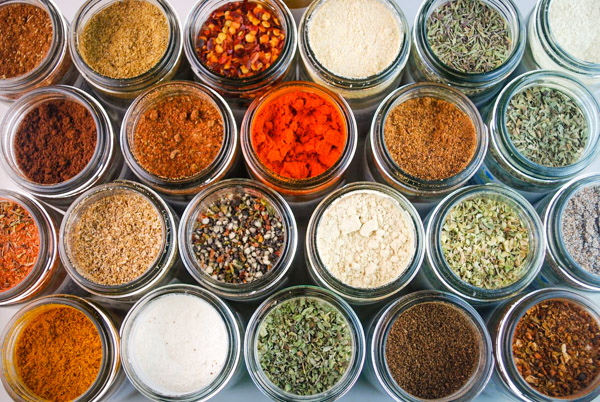
Cooking without spices is like having a dance party without music; the two just go together. These power packed tiny ingredients have a lot to offer apart from flavoring. Yes! I’ve heard plenty of stories of people who have healed various health problems through food. As Hippocrates, the famous Greek Physician once said, “Let food be thy medicine and medicine be thy food.” This makes it clear that people are aware that food can be used to treat or prevent health conditions. Most of us in the field of holistic medicine could spend hours discussing different approaches to food and diet. However, I think that we often overlook the power of a diet in terms of the abundance of benefits spices and herbs present in the food have to offer.
The history of spices is simply fascinating. It’s testimony to the fact that wars were fought over spices and kingdoms were lost over them. Spices were recognized as powerful medicine way back in 2600 BC. These herbs and spices not only add interest to our plates and palates, but they promote health in incredibly powerful ways. Ideally, the leaf of a plant used in cooking may be referred to as herb, and any other part of the plant, often dried, as a spice.
Spices can be the buds (eg. cloves), bark (eg.cinnamon), roots (eg. ginger), berries (eg. peppercorns), aromatic seeds (eg. cumin), and even the stigma of a flower (eg. saffron). Many of the aromatic seeds known as spices are actually gathered from plants when they have finished flowering. A familiar example would be coriander, with the leaves being referred to as herb, and the dried seeds as a spice.
Below is an extensive list of spices and herbs (Described in alphabetic order; Doesn’t mean it is in the order of their importance/benefits) that are worth adding to your culinary list owing to their key health benefits. We have split the blog into two parts for easy reading.
- Amchur: Amchoor or Amchur, also referred to as mango powder, is a fruity spice powder made from dried unripe green mangoes and is used as a citrusy seasoning. Mostly it’s used in Chutneys and Indian curries. Due to its high iron content it is popularly recommended for Anemia and Pregnant women. Also, it’s believed to reduce acidity and improve digestion.
- Asafoetida: The lingering odour of Asafoetida has given it many names like Devil’s dung and stinking gum. It’s commonly known as Hing in India. It’s warm in nature and that probably explains the reason it helps to increase the digestive enzymes. It helps reduce flatulence, digestive disorders, prevents constipation and is an excellent laxative. A pinch of asafoetida can be taken with buttermilk/water to reduce flatulence and cleanse the digestive system. Also, It’s believed to relieve menstrual pain. The active component of Asafoetida, coumarins can thin the blood and is believed to be anti-coagulant. Also, helps lower blood pressure.
- Black peppercorns : Also known as Kali Mirch. Piperine is the active ingredient in black pepper, and it has been shown to jumpstart digestion, prevent certain cancers and heart disease, lowers blood pressure, and prevents arthritis. Cases show that it has cholesterol lowering properties and help in cardiac function recovery especially after a heart attack. Overnight soaked peppercorns if consumed next day while having breakfast relieves migraine problem for most of them. The outer layer of peppercorn assists in the breakdown of fat cells. Therefore, peppery foods are a good way to help you shed weight. The antibacterial property of black pepper helps to fight against infections and insect bites.
- Basil: Also known as Tulsi in India and considered auspicious has medicinal usage extending from reducing ill effects of radiotherapy of cancer to optimizing kidney function to keeping cough and fever at bay. This herb has lot to offer. The strong anti-bacterial properties of Basil are known from years and hence owing to this property, basil is valued for its anti inflammatory. The active components i.e. eugenol and rosmarinic acid present in basil boosts production of serotonin and dopamine in brain. This could lead to sunnier mood in as little as 3 days. Basil also has a strengthening effect on kidney functioning. Consuming 5-6 leaves with water or crushing leaves to make juice and having with equal proportion of honey on a regular basis will improve overall kidney functioning and also aids in facilitating kidney stones through the urinary tract. Basil is a key ingredient in cough syrups and expectorants. Basil leaves can be used in the treatment of fever and common cold. Chewing some fresh basil leaves for relief from colds and flus is the best possible thing to treat naturally. Usually Smokers are prone for respiratory disorders and cancer. For both these, Tulsi is ideal. Having said that, care needs to be taken while handling this herb as the oils in basil are highly volatile, it is best to add the herb at the end of the cooking process, so it will retain its maximum essence and flavour !
- Bay Leaf : Bay leaves popularly known as Tej Patta are one of the main ingredients added to the popular Indian spice mix i.e. Garam Masala. Bay leaves help strengthen immune system and ward off urinary tract infection. Bay leaves have a very strong effect on the gut health. It helps in stimulating urination as a diuretic, which decreases the toxicity of the body, but can also stimulate vomiting (as an emetic) when something toxic has been consumed.
- Cardamom : Cardamom also known as Elaichi have aromatic and warming properties. They are believed to stimulate appetite and enhance digestion. It helps in stimulation and regular excretion of gastric juices. It helps in balancing these acids in cases of acidity, thus providing relief during heart burns. Those suffering from flatulence and gas gets a good relief when they chew cardamom after a meal. This helps those suffering from. Cardamom is also beneficial in relieving stomach cramps, hiccups, nausea, vomiting as well as constipation. Apart from health benefits, It is also valued for improving oral hygiene and eradicate fowl breathe.
- Carom seeds : These tiny seeds are popularly known as Ajwain or bishop’s weed in Indian Market. Ajwain contains high levels of thymol, a compound, which aids the release of gastric juices from the stomach which makes Ajwain`excellent indigestion reliever. To add more, it helps to deal with flatulence, nausea and colicky pain in babies. Ajwain has properties that help reduce inflammation and soothes irritated nerves. Because of this, it acts a great remedy to stop hiccups
- Cinnamon : Commonly known as Dalchini. Apart from its aroma and taste, the benefits of this spice can be attributed to its anti-bacterial, anti-fungal, anti-microbial and anti-clotting factor. Cinnamon is known for its role in the reduction of total and bad cholesterol (LDL) and increase in good cholesterol (HDL). It also helps improve insulin resistance and improves glucose tolerance in people with type 2 diabetes mellitus, thereby making it useful in diabetes management. Consuming Cinnamon plus honey has many benefits one of which is that it increases body’s metabolism and also helps in relieving gas and acidity.
- Clove: Clove or Laung is a pungent aromatic floral bud. The most prominent and common use of clove is alleviating symptoms of toothache and dental decay. The anti-inflammatory and analgesic components present in clove helps to reduce the swelling around an infected tooth and relieve pain. Plus, their antiseptic property will help fight the infection in the affected area and prevent it from spreading. Apart from this, Eugenol present in clove prevents clotting of blood and in purifying blood.
- Cumin: This spice which is native to Middle-East Asian region is one of the best spices to use to prevent and relieve gas. It is of beneficial to women after childbirth to shrink the uterus and increase breast milk. Cumin seeds (Jeera) also contains high amount of melatonin, which when consumed with bananas increases the production of chemicals within the brain. This combination helps beat
To be continued






